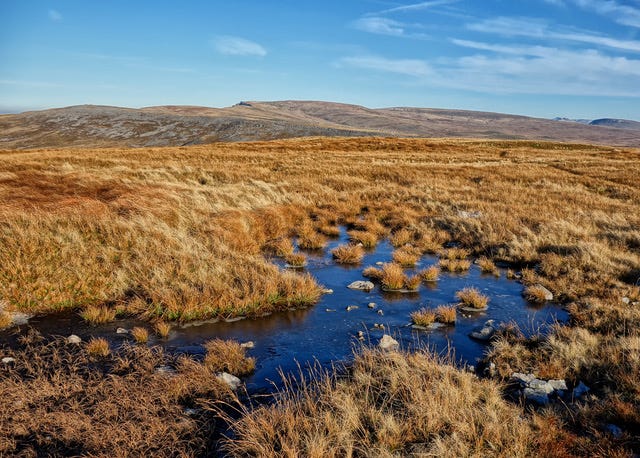Peatlands Under Threat Despite Welsh Government Promises
CPRW, the Welsh Countryside Charity, reveals new findings in the latest edition1 of its members’ magazine, Hiraeth, regarding serious concerns about the future of Wales’ peatlands. CPRW warns that the approval of wind farm developments on peatland threatens the Welsh Government's climate and biodiversity targets. It is evident that severe ecological damage has occurred at the existing wind farm sites.
Dr Jonathan Dean, CPRW Trustee, quoted directly from internal government briefing documents obtained under Freedom of Information legislation.
At Pen y Cymoedd in South Wales, the excavated peat had been destroyed and degraded. Stone was poured into trackways until it settled, interrupting the flow of water and degrading the habitat on either side. Additionally, borrow pits were left unrestored.
At Clocaenog, soil from a turbine base had been deposited on a peatland habitat, and other areas of peat soils had been excavated, left to oxidise, erode, and degrade. Further harm to peatland habitats is likely to occur, and additional financial resources will be needed to address the resulting damage.
The Garn Fach wind farm, located near Newtown, was approved in October 2024, despite being situated on protected peatland.
This led to the charity’s investigation. CPRW discovered that the wind farm was approved by Cabinet Secretary Rebecca Evans MS, despite the policy not to develop on peatland, according to internal government documents. The documents reveal that the wind farm was approved on the basis of “wholly exceptional circumstances” – contributing just 1% towards the Welsh Government’s net-zero renewable energy targets! As Dr Jonathan Dean notes, a marginal gain at a potentially irreversible ecological cost.
CPRW has uncovered conflicting briefings to ministers within departments: one permitting the destruction of peatlands by wind farm development, while the other aims to restore degraded peatland. A 2025 briefing to the Deputy First Minister warned that if the current pipeline of wind farm projects proceeds, the damage would “negate years of restoration activity.”
“It is evident that no peatland is safe from renewable energy development in light of recent planning decisions. As such, our climate and biodiversity strategies are significantly at risk. Our peatland is the most important natural carbon sink, which is being destroyed – how can the government claim to lead the way on net zero on one hand and destroy it on the other?”
Jonty Colchester, CPRW Chairman
CPRW urgently urges the Welsh Government to reconsider its policy approach and ensure that peat areas are excluded from the development of renewable energy projects. CPRW warns that millions of pounds spent on peatland restoration will be wasted if the Welsh Government doesn’t act now.
“There should be no conflict between the need to conserve and restore peatlands and the development of renewable energy. The issue is developers are picking the wrong places — and the government is letting them.”
Dr Jonathan Dean, CPRW trustee
What is the planning policy for peat?
Planning Policy Wales, Edition 12, February 2024 (PPW12)2 is at the heart of the matter in Wales and similar policies exist elsewhere in the UK. PPW12 emphasises the 'irreplaceable nature of peatlands' and outlines a step-wise approach to delivering sustainable development in their vicinity.
Key planning considerations for peat, as outlined in the document, include:
Protection of Peatlands: Peat soils are fragile and play a critical role in supporting ecosystems, storing carbon, and managing flood risks. Their protection is given considerable weight due to their environmental importance.
Avoidance of Development: Development proposals that may impact peatlands should be avoided unless there are significant and clearly defined public benefits. This aligns with the precautionary principle to safeguard these finite and rare resources.
Use of Peatlands Map: The Welsh Government provides the "Peatlands of Wales" map to assist in identifying peatland locations. This tool is essential for planning authorities and developers to understand the presence of peat and guide decision-making.
Step-Wise Approach: Planning authorities must follow the step-wise approach to avoid, minimise, mitigate, and compensate for any potential impacts on peatlands. This includes prioritising avoidance and ensuring any unavoidable impacts are mitigated or compensated appropriately.
Integration with Green Infrastructure Assessments: Peatlands should be considered as part of broader green infrastructure strategies to enhance ecosystem resilience and biodiversity.
Refusal of Permission: If development proposals fail to adequately protect peatlands or demonstrate significant public benefits, planning permission should be refused.
These considerations emphasise the importance of peatlands in environmental planning and their role in achieving sustainable development goals.
Issue 4: Spring 2025




When are governments going to learn that wind and solar are terrible ways to supply the grid? The sooner this belief is destroyed the better. However, I fear it will take some time.
They have little to no technical knowledge and accept biased advice.
It's amazing what information comes in when a post goes out!
A Welsh Government Press Release dated 25 September 2024.
https://www.gov.wales/welsh-government-beats-peatland-targets-year-early-saving-more-8000-tonnes-carbon-every-year